
The Sonoran Desert is a North American desert and ecoregion that covers large parts of the southwestern United States, as well as the northwestern Mexican states of Sonora, Baja California, and Baja California Sur. It is the hottest desert in both Mexico and the United States. It has an area of 260,000 square kilometers (100,000 sq mi).
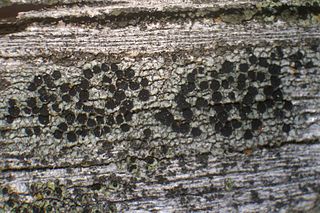
Buellia is a genus of fungi in the family Caliciaceae. The fungi are usually part of a crustose lichen. In this case, the lichen species is given the same name as the fungus. But members may also grow as parasites on lichens (lichenicolous). The algae in the lichen is always a member of the genus Trebouxia.
Flora of the Sonoran Desert includes six subdivisions based on vegetation types. Two are north of the boundary between the United States and Mexico, and four are south of the boundary. The flora of the Colorado Desert are influenced by the environment of the very dry and hot lower areas of the Colorado River valley, which may be barren, treeless, and generally have no large cacti. Flora of the Arizona Upland are comparatively lush, with trees and large columnar cacti that can withstand winter frosts. South of the border subdivisions are characterized by plants that cannot withstand frost.

Acarospora socialis is a usually bright yellow aereolate to squamulose crustose lichen in the Acarosporaceae family that grows up to 10 cm wide, mostly on rock in western North America. It is among the most common lichens in the deserts of Arizona and southern California. It grows on sandstone, intrusive and extrusive igneous rock such as granitics, in all kinds of exposures to sunlight, including vertical rock walls. It is found in North America, including areas of the Mojave Desert and Sonoran Desert region, to Baja California Sur. It is the most common yellow member of its genus in southwestern North America. It sometimes, but rarely, grows on other soil crusts. It is a pioneer species.

Candelariella aurella, the hidden goldspeck lichen or eggyolk lichen, is a yellow crustose lichen in the family Candelariaceae. It is commonly found on calcareous rock or wood or bark exposed to sunlight and which may have calcareous dust in areas with lime soils. The thallus is areolate with scattered small (0.1–0.3 mm), rounded to elongated yellow areolas. It has a global distribution and occurs on limestone and calcareous sandstone in the Sonoran Desert in Arizona, California, and Baja California. It occurs in Joshua Tree National Monument.
Lecidea hassei is an endolithic lichen that appears as tiny black, gray rimmed, plate-like or crinkled discs between crystals of rock in California. The main body grows inside solid rock (endolithic), and the crinkled discs above the rock surface are the sexual reproduction structures. It is endemic to California, where it only grows in the lower montane belt, including in deserts and chaparral. It occurs in Joshua Tree National Park. The sexual reproduction structures (apothecia) are black, thinly rimmed with unpigmented fungal tissue surrounding black discs in the middle, and up to 2.2 mm in diameter. They rise out of the rock in a flat to convex disc with a constricted base, giving the appearance of tiny raised plates. It grows in open areas on granite, schist, and other acidic rock. It resembles Lecidea laboriosa but produces schizopeltic acid as a metabolite, instead of 4-O-demethyl planaic acid. The name is from H.E. Hasse, who wrote the 1913 "Lichen Flora of Southern California". It is classified by the fungus as being in the Lecidea genus of the Lecideaceae fungus family. Lichen spot tests are negative on both the cortex and medulla.
Caloplaca durietzii, or Durietz's orange lichen, a smooth surfaced yellowish orange crustose areolate lichen with elongated lobes that grows on wood or bark in southwestern North America. It is commonly seen growing on old junipers in Joshua Tree National Monument in the Mojave Desert. It is in the Caloplaca fungus genus of the Teloschistaceae family.
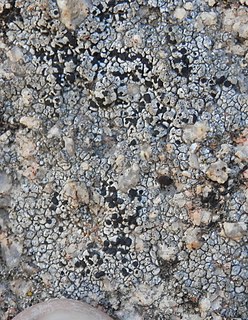
Buellia dispersa is a dull white to beige or dark brown crustose areolate lichen that grows on non-calcareous rock, such as basalt, granite and gneiss, in arid to semi-arid areas of northern Africa, Europe, and southwestern North America. The areolas are distinct, becoming subsquamulose when separated and collecting in irregular patches, otherwise they form rosettes with lobed margins. There is no prothallus. It commonly occurs in the Mojave Desert, Channel Islands, and Santa Monica Mountains, also in the Cuyamaca Mountains, Santa Ana Mountains, and San Jacinto Mountains. It is among the most common lichen species in the Sonoran Desert.
Xanthoparmelia maricopensis, the Maricopa rock-shield, is a 2–6 cm (0.8–2.4 in) wide, yellow-green foliose lichen in the Parmeliaceae family. It grows on igneous rock in southwestern North American deserts.

Lecanora muralis(Protoparmeliopsis muralis) is a waxy looking, pale yellowish green crustose lichen that usually grows in rosettes radiating from a center (placodioid) filled with disc-like yellowish-tan fruiting bodies (apothecia). It grows all over the world. It is extremely variable in its characteristics as a single taxon, and may represent a complex of species. The fruiting body parts have rims of tissue similar to that of the main nonfruiting body (thallus), which is called being lecanorine. It is paler and greener than L. mellea, and more yellow than L. sierrae. In California, it may be the most common member of the Lecanora genus found growing on rocks (saxicolous).
Circinaria arida is a 0.5–6 cm, light olive-brown custose lichen that grows on rock, often like a cluster of little light brown to olive balls growing on pebbles, in the southwestern deserts of North America. It is also found in Eurasia, and arid parts of North America from the southern Great Plains and Midwest to California. It is warty (verrucose) with the warts sometimes cracking apart areolate. The warts or areolas have angular to rounded sides. The 0.2-2.3 mm, convex to flat-topped areolas are separated by deep fissures that may be as deep (0.1–2 mm) as the areaola is wide, so the lichen often appears to be made of clusters of little balls crammed up next to each other, although the areolas are sometimes isolated. In California it is commonly found growing on pebbles. Each areola has a single sunken black, dust covered (pruinose) fruiting body (apothecium) with a white rim. A thin strip of prothallus sometimes is at the outer edge, forming a narrow dark zone (fimbriate). The similar Aspicilia desertorum has a white pruina on the apothecia. It is negative for lichen spot tests, I-, K-, P-, C-.
Clavascidium lacinulatum is a dark brown squamulous terricolous lichen. In Joshua Tree National Park, it is the most common of the biological soil crust lichens.
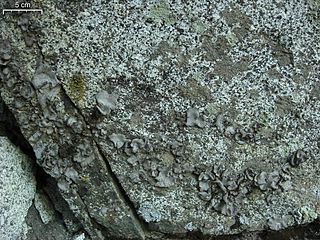
Dermatocarpon americanum is a silvery-gray, leafy (foliose) lichen with black dots that is common on near seeps in rock faces from southwestern North American deserts to coastal areas. It has a silvery-dusty looking coating. It is common in deserts on vertical rock surfaces that are partially shade protected near seepages.

Aspicilia phaea is a grayish brown to tan areolate crustose lichen commonly found on rock in coastal to inland parts of central and southern California. Described as new to science in 2007, it is endemic to California. It grows on exposed or partially shaded siliceous rock, with a few known occurrences on serpentine rock.

Buellia abstracta is a crustose lichen.
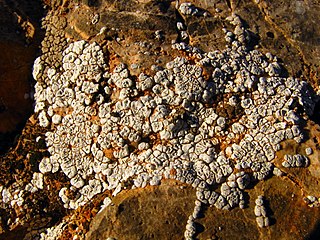
Acarospora strigata is an areolate to verruculous crustose lichen that grows on rock around the world, in full sun or shade, and in mesic to arid habitats. It is brown but may appear white or pale gray if it is covered in a pruina. The lichen is common in southwestern deserts of North America.

Acarospora fuscata is a glossy pale or yellowish-brown areolate lichen with angular areolas that grows up to 10 cm (4 in) wide on non-calcareous rock in low and high elevations. It grows in Europe and North America. It grows in southern California and on the eastern part of the Sierra Nevada range. It may grow with the areolas disconnected. The areolas may lift at the edges, but the areolas do not overlap like true squamules (sub-squamulose). More common in the Sierras is the similar species Acarospora thamnina, which is truly squamulose with overlapping scales.
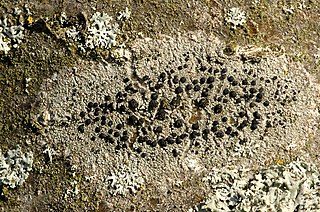
Buellia disciformis, the boreal button lichen, is a thin, bluish to pale gray rimose to areolate crustose lichen that grows on bark in temperate forests in the northern USA and Europe, and at high altitudes in Arizona, down to 500 metres (1,600 ft) in coastal areas of California. Flat apothecia with black discs are .2-.7 mm in diameter and sessile, with noticeable lecideine margins. Lichen spot tests are negative except for K+ yellow. Secondary metabolites include atranorin, fulgidin, and sometimes traces of fulgoicin and norfulgoicin. B. erubescens is similar and more often found on wood than the bark loving B. disciformis, and has smaller spores.
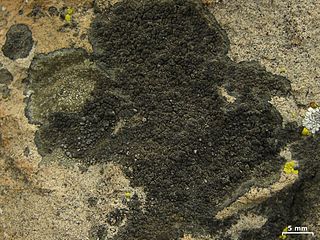
Buellia badia, the parasitic button lichen, is a dark chocolate-brown crustose areolate lichen of Europe, northern Africa, and North America that starts as a parasite growing on other lichens, such as Aspicilia phaea, gradually then becoming independent growing on rock (sometimes also on hardwood. Areoles may be contiguous or dispersed. Lecideine apothecia are 0.3 to 0.9 mm in diameter with black discs, that are initially flat, then become strongly convex as they age. Lichen spot tests are all negative. There are no known secondary metabolites as of. It is similar in appearance and other ways to the chocolate brown Dimelaena californica, which also starts off as a parasite on other lichens, and has spores of similar shape, size, and internal construction. D. californica has not been found on wood, is more preferential as to the lichens it starts growing on, and commonly has norstictic acid as a secondary metabolite. Some think they should be included in a new, third genus.













